By Phil Zimmer
Sergeant Alfred Johnson peered from behind a boulder on a rock-strewn hillside at Piano Lupo about six miles inland from the southern coast of Sicily. As he glanced down a big valley to the north, Johnson spotted tanks moving in a tight pattern some 2,000 yards away, their pennants flapping colorfully in the wind.
What a beautiful sight, he thought. The U.S. Army must have offloaded the tanks early on July 10, 1943.
But then it hit him. They were not American tanks. He barked orders to his 1st Infantry Division men to quickly dig into the rock-hard, sun-baked Sicilian soil. The veteran of the fighting in North Africa clawed feverishly at the terrain, determined to dig a foxhole that would protect his six-foot two-inch frame from the oncoming Tiger tanks. He wanted it deep enough to protect him from the powerful panzers firing their heavy shells into American machine-gun positions, trucks, and jeeps.
It was pure chaos. The panzer crews machine-gunned the Americans and deliberately spun their machines atop foxholes until the man beneath was little more than a red stain in the parched earth. The panzers turned toward Johnson, and less than 100 yards away a brave but foolhardy lieutenant stood up, aimed his .45 Colt pistol, and fired a few rounds as a panzer lumbered toward him. The panzer crushed him, leaving a yard-wide mess in its wake.
Johnson flopped deeper into his foxhole and began reciting the Lord’s Prayer. All his other men were quiet, save for Richards, an American Indian who began chanting in his native tongue. Johnson recalled being told in a briefing aboard ship before the landing that the panzers were in northern Sicily, and therefore it would take two to three days for them to get near the southern beachheads. But the enemy had arrived sooner than expected. Johnson contemplated his next move as the tanks moved ever closer. In desperation, some men stood up, hands raised. Some were machine gunned by the panzer crews, and others were simply flattened by the 57-ton steel monsters.

American artillery opened up but did little damage. A U.S. light cruiser slipped in close to shore and began lobbing six-inch high-velocity shells at the panzers. The naval shells took their toll and gave the men a brief respite as the panzer company pulled back to regroup.
The Americans and British were ashore, but Operation Husky, as the Allied invasion of Sicily was code named, was only at the beginning of a long, frustrating struggle that would last 38 grueling days. The invasion consisted of a series of battles pitting the Allies against veteran and fanatical German forces.
Operation Husky marked the largest amphibious landing to date in world history with seven divisions initially put ashore, two more than would land at Normandy on June 6 the following year. Nevertheless, poor and incomplete planning, insufficient communications, indifferent tactical air support, rivalry, and fratricide marked the Sicilian campaign.
Planning for the invasion began even before the last shot was fired in the preceding North African campaign. But even then there were signs of problems to come. Great Britain had been at war for nearly four years, and it was stretched thin with more than 100,000 battle deaths and the loss of another 65,000 civilians and merchant mariners to the German onslaught.
The once undersized U.S. Army had now mushroomed to some six million soldiers. The army as a whole was trying to find its footing and gain experience against the mighty Wehrmacht, which following its invasion of Poland in 1939 had overrun much of Europe and a good portion of the Soviet Union. The U.S. Army’s poor showing early in North Africa at the Kasserine Pass cast long shadows and raised grave concerns among both American and British commanders.
British Prime Minister Winston Churchill and his generals had cajoled the Americans into the attack on Sicily. General George C. Marshall, the U.S. Army chief of staff, and other Americans initially opposed the venture. They contended that a Sicilian campaign would invariably lead to an invasion of Italy that would siphon experienced troops and precious war matériel away from a cross-Channel invasion of France that offered a more direct thrust into the heart of Germany. Marshall and like-minded thinkers believed the British fixation on Sicily and Italy belied their colonial interests and a hesitancy to again risk the horrendous losses suffered a generation earlier in the trench warfare on the Western Front during World War I.
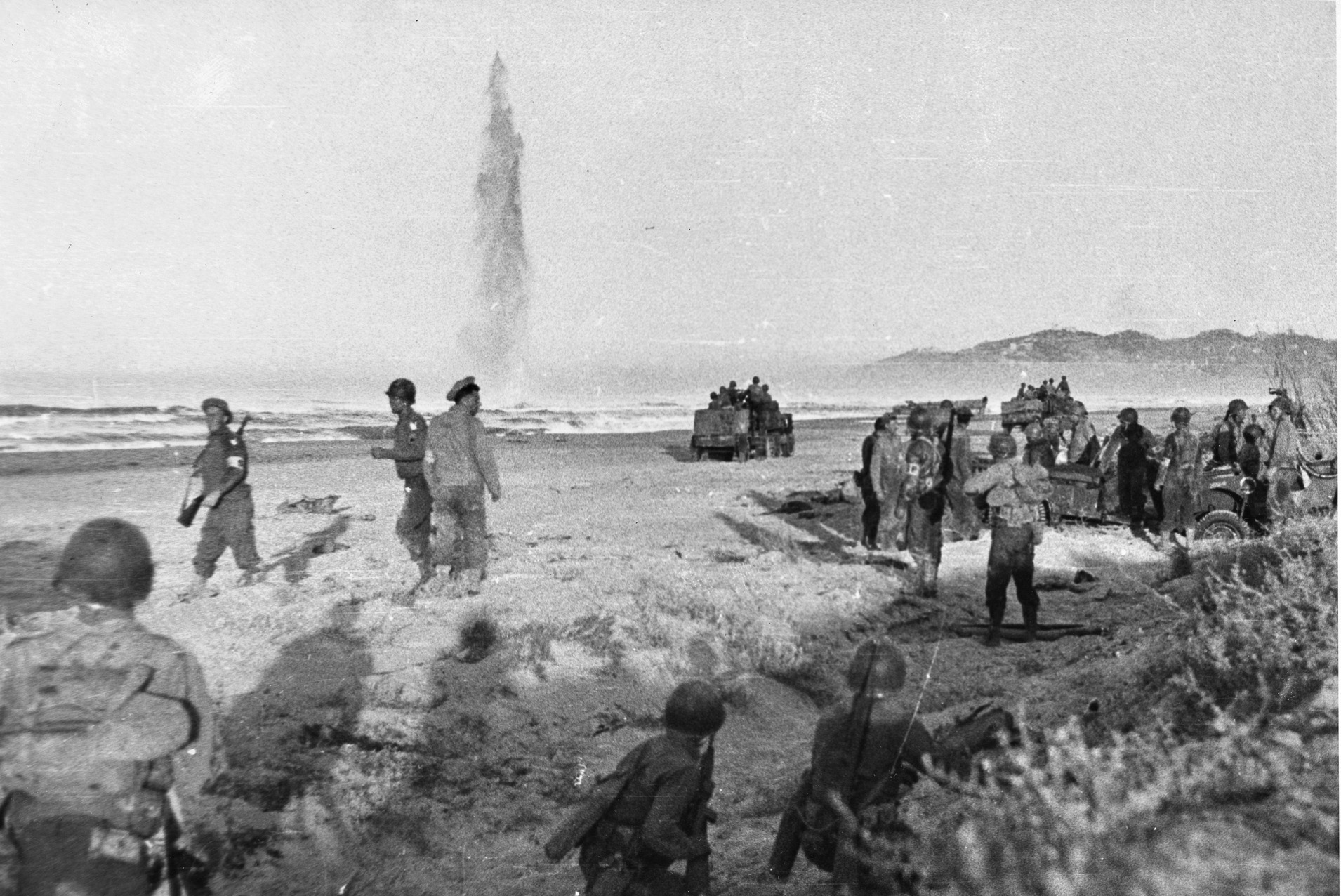
British General Bernard Montgomery, who was to lead the British efforts on Sicily, continually put off planning for the invasion, contending that he needed to focus first on mopping up the Axis in North Africa. The initial planning went ahead without Montgomery and called for the British to land in southeastern Sicily and the Americans to take Palermo, the capital, on the northwestern coast. From there the Allies would move forward to squeeze the enemy into submission. Little substantial thought was given to air cover or in closing off the Straits of Messina, the gateway to the Italian mainland.
When the prickly Montgomery, whose ego was inflated as a result of his recent victory at El Alamein, finally got around to reviewing the plans, he called for a nearly complete revision. Never at a loss for words, Monty said the initial plan “breaks every common-sense rule of practical battle fighting and is completely theoretical. It has no hope of success and should be completely recast.” His criticism unleashed harsh comments from others who also had reservations about the plan. Much of the concern centered on the idea that the enemy might crush one of the two invading forces before taking on the other; mutual Allied support would not be possible with such a widely separated, two-pronged amphibious invasion of the island. For that reason, Montgomery held out for an additional division as part of the overall effort to subdue Sicily.
The clamor for additional troops and matériel, as well as a call to rethink the entire plan, eventually reached Churchill. The British prime minster dashed off an acid-laced letter on April 8, 1943, to the British chiefs of staff. He chided those with “pusillanimous and defeatist doctrines” who shied at attacking the two German divisions on the island. He also lashed out at the planning staffs “playing on each other’s fears” and the “total absence of one directing mind and commanding willpower.” Churchill chided their timidity when faced with two enemy divisions at the very time the Soviet Union was entangled in a life-or-death struggle with 185 German divisions.
The plan was revised, with four British and three American divisions landing along a 100-mile stretch of beach on southeastern Italy. Palermo would have to wait. In addition, portions of two airborne divisions and eventually 13 Allied divisions would be committed to the invasion.
Despite the revised planning and the increased troop strength, the Allies missed seeing the need to seal off the two-mile-wide Strait of Messina to prevent Axis resupply and later prevent the escape of German and Italian forces to the mainland. The planning was so heavily focused on the capture of southern ports and nearby airfields that little thought was given to areas beyond the beachheads. What is more, the Americans would not have a large port to support their movement inland.
One aspect of the planning did go well. Efforts at misdirection and misinformation proved exceptionally helpful. The clever deployment of a supposed British officer’s corpse found floating off the coast of Spain with detailed but false plans in his briefcase convinced many high-ranking Nazis that the coming Allied invasion would occur in southern Greece rather than Sicily. That area was beefed up rather than Sicily’s defenses.
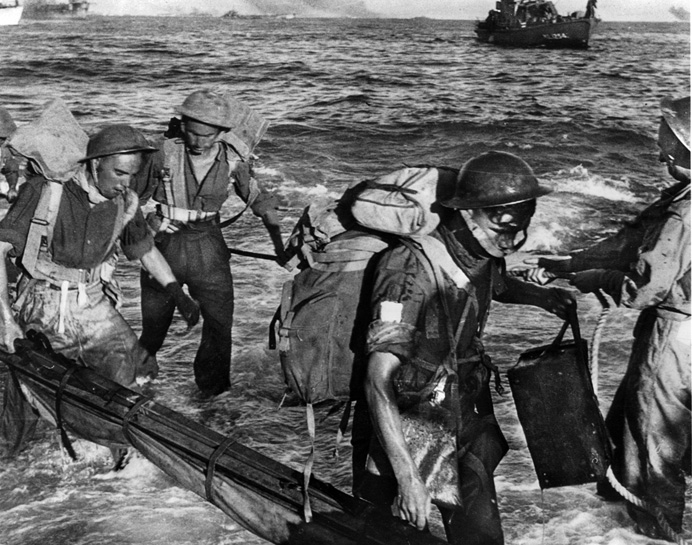
As it steamed toward Sicily, the Allied invading force with its 3,200 ships was the largest amphibious operation of World War II up to that time. There were an estimated 300,000 Axis troops on Sicily, mostly Italian troops of questionable quality backed by two top-flight German divisions, Generalleutnant Paul Conrath’s Luftwaffe Panzer Division Hermann Göring and Generalmajor Eberhard Rodtfrom’s 15th Panzergrenadier Division. Operation Husky also included the largest Allied airborne assault yet attempted.
The risks were substantial and were compounded by the poor planning. Amphibious landings over the centuries had proven horribly inflexible once unleashed, largely because of difficulties in synchronizing the attack. “Seldom in war has a major operation been undertaken in such a fog of indecision, confusion, and conflicting plans,” Maj. Gen. Omar Bradley said afterward.
The American attack was to fall on and around Gela, a town of 32,000 located on a hill overlooking the Mediterranean. More than 3,000 paratroopers under Colonel James Gavin were to drop the night of July 9-10 on crucial road intersections north of the town and serve as blocking units protecting the troops landing in the morning light. Hardly anything went right for the paratroopers; many were scattered widely over the island and others were machine gunned as they descended. Only about 15 percent landed anywhere near where planned, and those who had the misfortune of landing in the sea needed to quickly dispose of their 82 pounds of kit before making an attempt get ashore. Those who did land on firm soil quickly moved to cut telephone lines, attack couriers, and create confusion.
The first American infantry started coming ashore shortly after 3:30 am. Shortly thereafter the Italians blew up a sizable portion of the 1,000-foot-long Gela pier, and gunners lashed the waters with bullets as the 16th Infantry came ashore. In the confusion one soldier said, “I’ve been wounded, but there’s so much blood I can’t tell exactly where.” Another was about to leave his landing craft when he felt a weight against his leg. Shouting that someone had left his pack behind, he looked down and saw the crumpled body of a sergeant who had taken a fatal shot to the head.
Daylight did not brighten the situation for the Americans. The rough seas tangled the hard to manage pontoon bridges, and many men resorted to rubber boats to get ashore. One new contraption, a seagoing vehicle nicknamed a DUKW, or Duck, proved a godsend in getting men and equipment safely ashore.
Even after the U.S. troops were ashore, matters were still desperate. Contrary to intelligence reports, the American beaches were thoroughly mined. The dune exits also were mined, and many vehicles were blown up as they attempted to worm their way off the beaches. This held up attempts to get inland. Operable mine detectors were at a premium; many had shorted out when brought ashore, and others remained aboard ship. The scene on the beaches became a madhouse with exploded and burning vehicles blocking the exits, trucks mired in the sand, and boats overturned. Men searched desperately for fuel and ammunition in the stores brought ashore, often finding only clerical records and miscellaneous matériel.
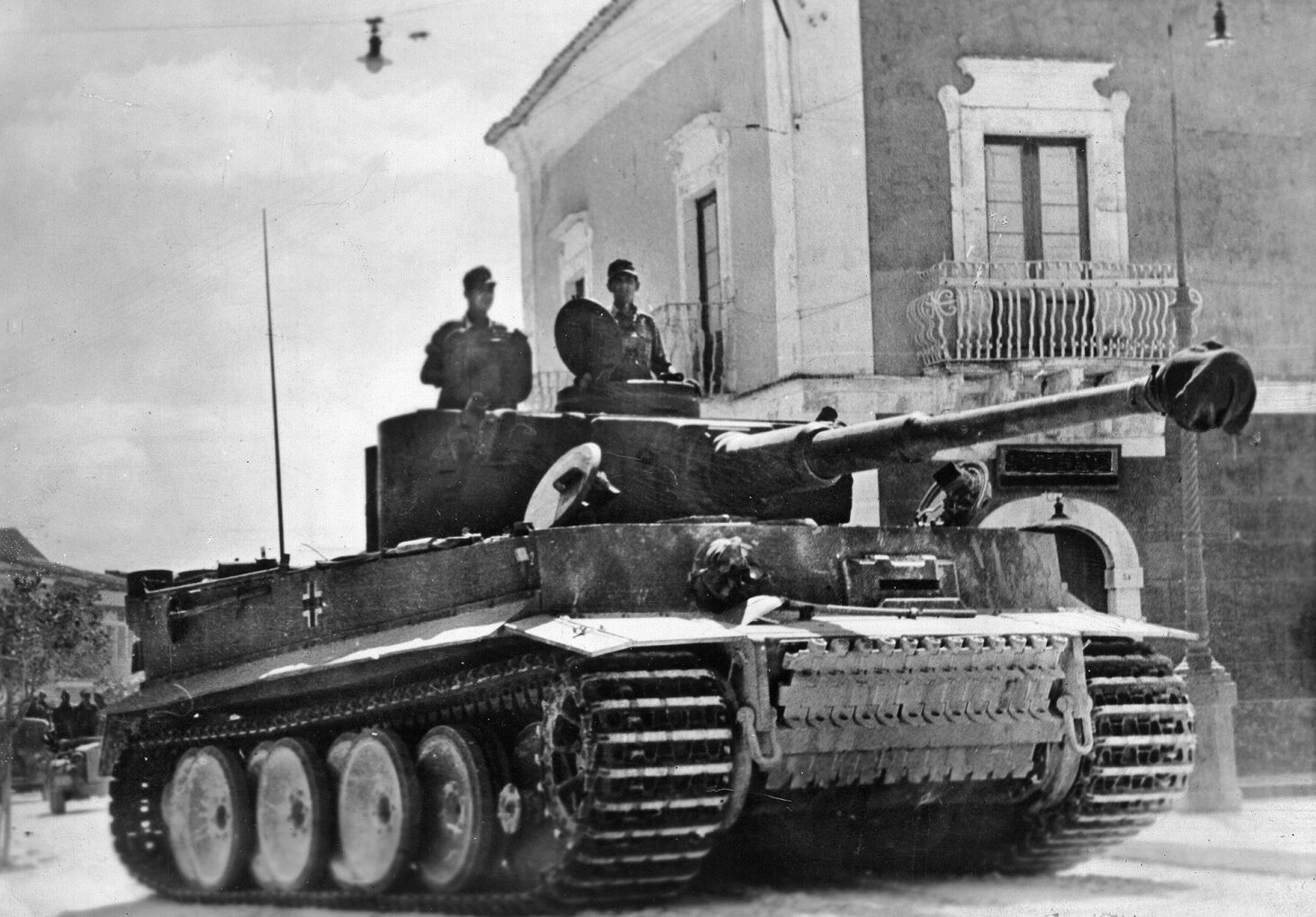
Lieutenant Colonel Bill Darby’s 1st Ranger Battalion pushed into Gela as naval gunfire destroyed buildings in front of them. The Rangers forced Italians from the Livorno Division to surrender after a brief firefight. Farther inland, Gavin’s paratroopers tangled with 32 light Renault tanks and Italian infantry. Salvos from the cruiser USS Boise slowed the enemy, although 20 of the tanks managed to press forward toward Gela until rounds from the 16th Infantry Regiment forced the enemy to flee northward toward safety.
Another 24 Italian tanks trundled southward from Ponte Olivo to be met by shellfire from the destroyer USS Shubrick. The naval shells set several enemy tanks ablaze, but 10 of the light tanks did reach Gela to face stiff resistance from the determined Rangers. The Americans fired bazookas, tossed grenades, and lobbed TNT from rooftops in an effort to stop the Italian tanks. In a movie-like sequence, the quick-thinking Darby directed his driver to the beach where he commandeered a 37mm antitank gun, used an ax to free shells from a crate, and returned to Gela. Darby lined up the gun and brought a tank to a stop with his second round. The Italians tumbled out in surrender as the other tanks fled northward to safety. About that time, Italian infantrymen marched toward Gela from the west and were cut down with the survivors fleeing in disorder.
The Germans also made a run at the invaders, the Hermann Göring Division launching a counterattack with a tank-heavy task force heading south along the Niscemi Road when it encountered Sergeant Johnson’s 1st Division and elements of the 82nd Airborne Division at Piano Lupo. The attackers were supported from the east by an infantry-heavy German force also aimed at Piano Lupo. The tank crews fell prey to the heavy naval gunfire from American cruisers and destroyers located offshore. This compelled them to make a hasty withdrawal northward toward Niscemi.
Gela was secured for the time being by late morning, and things also went well some 15 miles west at Licata. The 3rd Infantry Division, a Ranger battalion, and a gaggle of American tanks found mine-free beaches and few Italian artillery positions. American destroyers covered the landing craft, and within an hour, according to most reports, 10 battalions made it ashore complete with tanks.
The third prong of the American attack located across the Gulf of Gela went badly. Twelve-foot swells and high surf buffeted the invaders. Inexperienced coxswains landed the first assault on the wrong beach, and others in the 45th Division and the 180th Infantry were splayed across a 12-mile stretch of Italian shoreline. While landing was difficult, unloading was even more problematic in the wild seas and chaos onshore. Congestion and the pilfering of supplies by Army shore parties exacerbated the situation. Some landing waves were diverted to secondary beaches where engineers blew up dunes to create access inland. Worse still, the growing congestion prompted some captains to head for North Africa without unloading.
By nightfall, the Americans were ashore and in command of their crescent along the beach. Some 5,000 vehicles and 50,000 Americans were planted on the Sicilian coast, sharing their rations with hundreds of Italian prisoners.
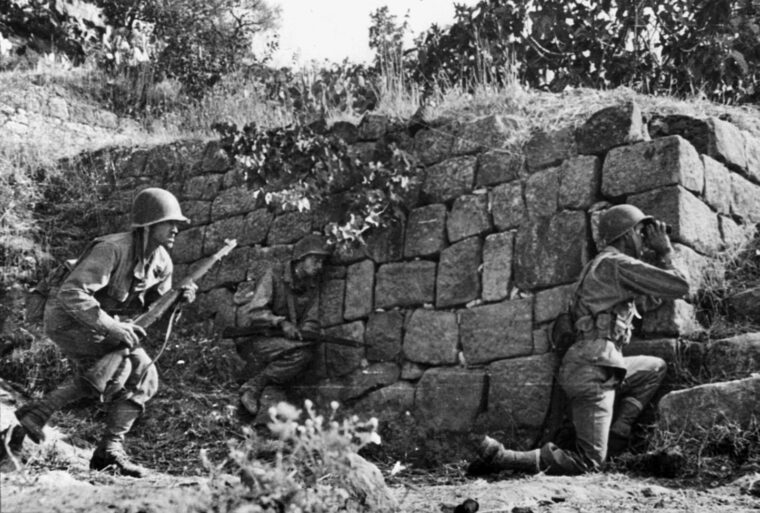
Thirty-five miles to the east, the British landings were led by commandos who landed early and took out Italian coastal artillery batteries at Cape Murro di Porco and Cassible. Subsequent landings were made by the Canadian 1st Division and the British 5th, 50th, and 51st Divisions. The rough seas played havoc in this sector, too, and the naval transports dropped anchor some 12 miles off the coast rather than the planned seven. As a result, many of the men were confined to their small landing craft for several hours and were wet, cold, and seasick as their craft putted toward shore.
The poorly equipped and poorly led Italians put up some resistance to the British and Canadian invaders before either surrendering or retreating into the island’s interior. The British Eighth Army continued to land throughout the day, taking the vital Ponte Grande Bridge just south of the crucial port city of Syracuse and pushing on toward that city located farther up the eastern coast. Air or naval gunfire took out any remaining Italian batteries in the area, while Canadian troops took the abandoned Pachino airfield. The British and Canadian beaches were soon jammed with artillery, vehicles, and related war matériel.
The taking of the key Ponte Grande Bridge was not without problems. Montgomery had planned to have 1,700 men in 144 gliders land in the dead of night, capture the bridge, and secure Syracuse, which would give the Eighth Army a major port. At that point in the war, experience was at a premium, and the pilots of the tow planes had little nighttime navigation experience and even less experience towing packed seven-ton gliders at the end of 350-foot-long nylon rope tethers. And the glider pilots themselves lacked sufficient experience for the undertaking.
As the glider disaster unfolded in the turbulent nighttime sky, one glider pilot actually put down on Malta, thinking it was Sicily, and another inexplicably landed in Tunisia. Most of the gliders did arrive in Sicily, but many were cut free of their tug planes too early. Fifty-four gliders made land, a large number ditched in the Mediterranean, and 10 vanished. The Allies managed to make the bridge, tear out the demolition charges, and seize the structure.
The taking of the Ponte Grande Bridge came at an exceedingly high price. More than 600 men were lost, most of them drowned. Anger at the American tow pilots grew to the point where surviving British arriving back in Tunisia were kept well away from the Americans to prevent possible problems.
Montgomery came ashore near Pachino early on Sunday, July 11, shortly after Syracuse had fallen and the vital port was seized intact. By that time, the Allies had a secure foothold on the southern shore of Sicily, but the Germans were planning a major counterattack. Field Marshal Albert Kesselring issued orders for his men to attack Gela early on Sunday, July 11, and force the impertinent Americans back into the sea.
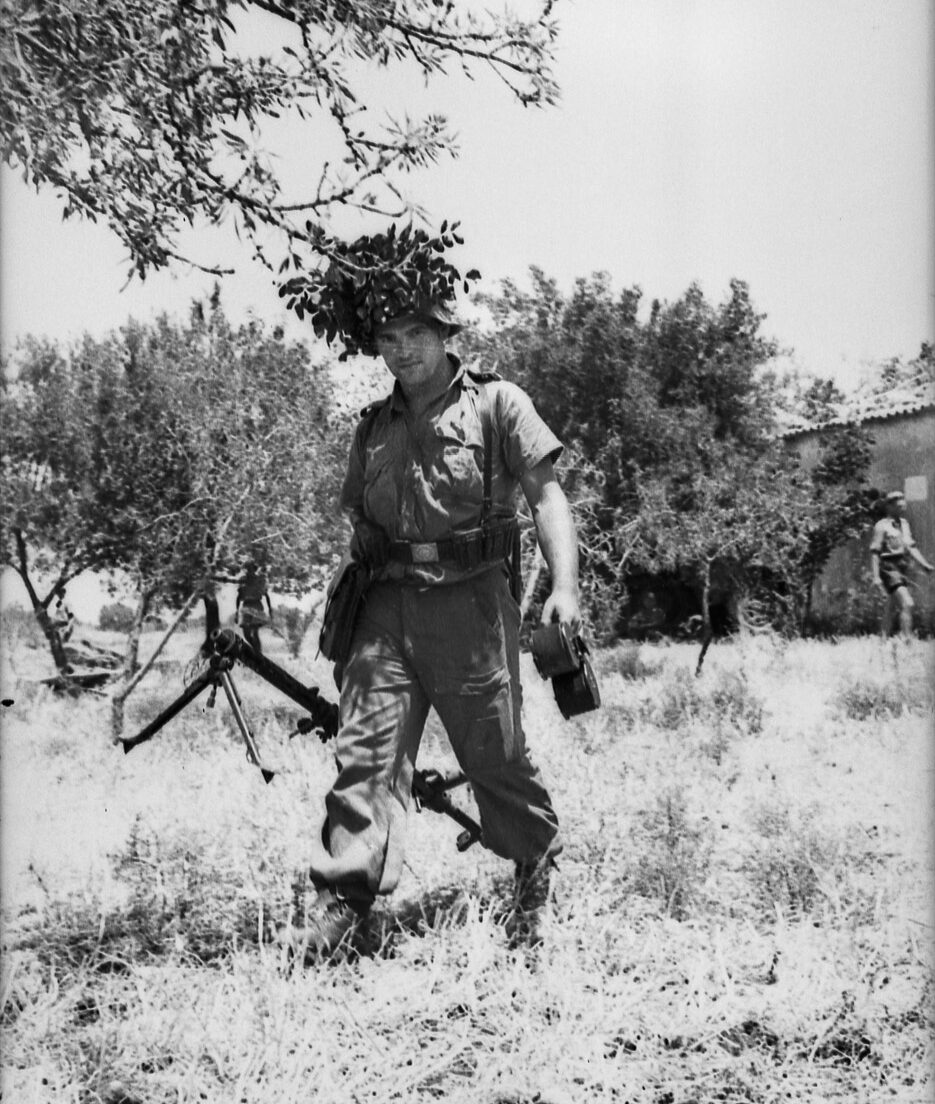
The fighting began early on July 11. The 26th Infantry advanced north along Highway 117 on the left, and the 16th Infantry pushed in the same direction on Highway 115. The regiments ran directly into the path of German panzers headed toward the Gela beachhead. The panzers on the left scooted past the pinned-down American infantry, swerved across wheatfields, and rolled on toward the beaches. Brig. Gen. Theodore Roosevelt Jr., son of the former president and second in command of 1st Division under Maj. Gen. Terry Allen, was near the front. He got on the horn and called for American tanks to counter the fast-moving threat.
Like his father, Roosevelt was never one to run from a fight. The 55-year-old rallied his riflemen, most of whom were young enough to be his sons. “Do you know who those bastards are?” he said. “The Hermann Göring Division. We beat their asses in North Africa and we’re going to do it again!” Matters were even more dicey on the right where the 16th Regiment’s 2nd Battalion held off 40 panzers for two hours before two companies moved back without orders, digging in at Piano Lugo.
Thirty panzers were spotted shortly after 10 am northeast of the Gela-Niscemi road junction. The situation was growing more desperate by the minute. The regiment had lost nine antitank guns, two battalion commanders had been badly wounded, and officers desperately resorted to shooting at the panzers’ observation slits with their pistols. Allied confusion was everywhere, including the beaches that had been hit at first light by Italian dive bombers with successive air attacks continuing. In desperation, a number of mortar men commandeered small fishing boats to row ammunition ashore past the floating debris and the equipment stored along the waterline. Sixty Sherman tanks managed to get ashore that day, but only four managed to successfully navigate the tangle of equipment and the dunes to make it into battle that morning.
The Germans were not without problems. Two regimental commanders were relieved of their duties, and the large Tigers often broke down, blocking the advance. The Italians had moved forward, too, but not in coordination with their German allies. By midday Sunday, the Axis front was extended in a loosely held 18-mile arc.
Lieutenant General George Patton, commander of the U.S. Seventh Army, came ashore at 9:30 am Sunday, July 11, near Gela and made it to a rooftop to observe what he could despite the dust kicked up by the oncoming German tanks to the north and east. He spotted Italian tanks nosing within a mile of Gela and shouted to a naval ensign below to contact his superiors and request shellfire to protect the American positions.
Thirty-eight shells from the cruiser Boise roared down on the enemy tanks, followed by mortar shells landing among Italian infantrymen. This effectively stalled the Italian attack, but incoming German 88mm fire and bombs from two German aircraft demonstrated that the fight was far from over. German tankers at Santa Spinta controlled the coastal highway and were less than a mile from the beach, threatening American supply dumps.
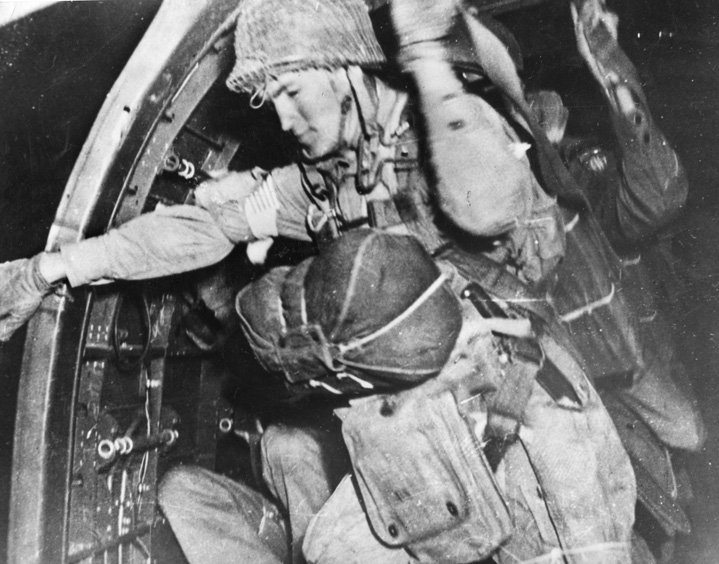
Allen called for more firepower, and he got it in the form of 48 artillery pieces, Sherman tanks, and antitank companies. Shells from the Boise and the cruiser Savannah filled the air, and the Germans called off the counterattack by 2 pm.
Sunday also brought a fresh round of enemy air attacks, largely unmolested by Allied planes. More than 4,500 Allied planes had been assigned to Operation Husky, but few on the ground knew where they were.
In the first three days of Operation Husky the Germans lost more than 625 men dead or wounded and had 10 Tigers destroyed, while the American Seventh Army reported 175 dead and 665 wounded in the first two days of fighting.
Sunday night was to bring more confusion and more losses as 2,300 men from the 504th Parachute Infantry Regiment, 82nd Airborne Division, jumped from C-47 transport planes. Despite personal efforts by Patton and Maj. Gen. Matthew B. Ridgway to alert skittish gun crews that friendly parachutists were on the way, many did not get the message. The resulting fratricide was deplorable. One hundred and forty-four planes were flying that night; 23 planes were destroyed and another 37 were heavily damaged with the casualties running at more than 400 men. “The safest place for us tonight would have been over enemy territory,” quipped one pilot.
By Monday, July 12, the Allies had a firm foothold on a 100-mile arc with some 80,000 men ashore along with 300 tanks, 7,000 vehicles, and 900 guns. The British had Syracuse and had begun moving toward Catania, one of the last perceived obstacles before Messina, some 45 miles farther away at the northeastern tip of Sicily. The strutting Montgomery predicted that Catania would fall soon, possibly by Tuesday evening.
But it was Tuesday, July 13, when Montgomery unilaterally ordered his troops to cut across Patton’s front on Highway 124 as part of the British Army’s two-pronged effort around Mt. Etna. Patton’s army was left protecting the British flank, and the American 45th Division was turned back toward the beach for a shift to the west. This turn of events proved controversial because if the Americans had seized the road near the town of Enna they probably would have prevented the Axis forces in the west from fleeing eastward to form a defense around Mt. Etna.
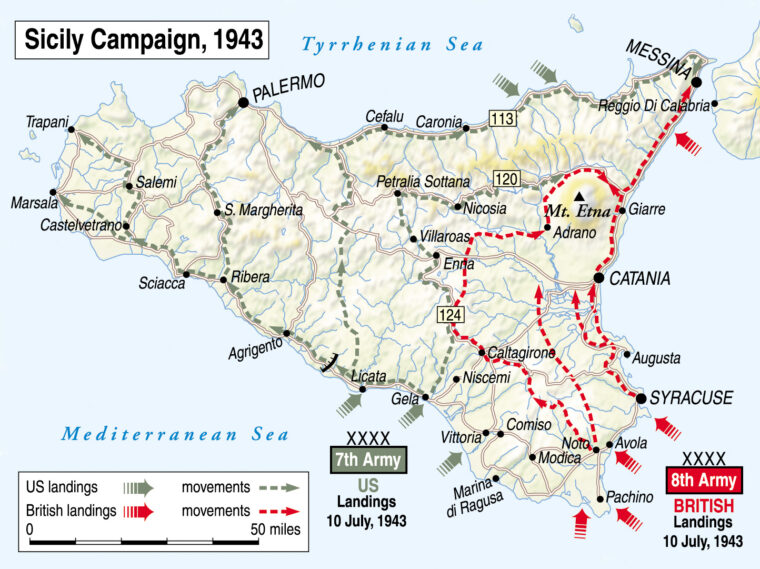
Montgomery was now left with the full bag; half his troops headed toward tough terrain at Enna far from Royal Navy fire support and the other half 45 miles away toward Catania. Patton sized up the situation immediately, but because of an earlier spat with theater commander General Dwight D. Eisenhower he chose not to speak up. Patton’s choicest words were left in his private diary: Montgomery had best “stay out of my way or I’ll drive those Krauts right up his ass.”
Montgomery’s action created further distrust and unease between the Allies. Even many of his British colleagues were taken aback by Montgomery’s move on Enna and Highway 124. One must remember, one British commander said, that Montgomery “is not quite a gentleman.” He supposedly shunned attention, but he nevertheless had a habit of “backing into the limelight,” said one wag.
The British started encountering difficulties in their advance while German troops in the western section of the island fled eastward toward Mt. Etna and the Messina Peninsula. With difficulty, the British managed to eventually take and hold the Primosole Bridge seven miles south of Catania on July 16, but a German defensive line just north of the bridge was to defy the attackers for two weeks. The Eighth Army found it tough going in the interior too, with the rugged terrain unsuited to tank warfare. As his advance stalled, Montgomery further divided his army, sending his XIII Corps farther west in an attempt to outflank the enemy only to find that the Germans had seized the high ground and could bring down artillery fire on those below.
By this time Patton had taken enough of being shunted from the main action by the British. On July 1, he grabbed his maps and flew to Tunisia for a meeting with General Harold Alexander, overall head of Operation Husky. Patton argued that his Seventh Army should drive northward from Gela and take Palermo, 80 miles away.
Alexander listened patiently. He gave Patton the go ahead, although he questioned the fighting acumen of the Americans. The wiley Patton had already given his men the green light before Alexander’s approval and had sent Darby’s Rangers 10 miles north up the coast to Agrigento. With assistance from Maj. Gen. Lucian Truscott’s 3rd Infantry Division, they seized Agrigento and Porto Empedocle, scooping up 6,000 prisoners in the process.
The American force continued to move northward during the next several days with numerous small towns falling with little or no resistance. The 3rd Infantry aptly demonstrated the “Truscott Trot,” making some 4.5 miles per hour on foot despite the summer heat and the thick, choking Sicilian dust. Alexander’s effort to moderate the forward momentum was ignored by the Americans as Patton urged his forces onward. Bradley proudly displayed his map of Sicily showing large areas colored in blue signifying areas taken by the Americans and a much smaller red-colored area held by the British.
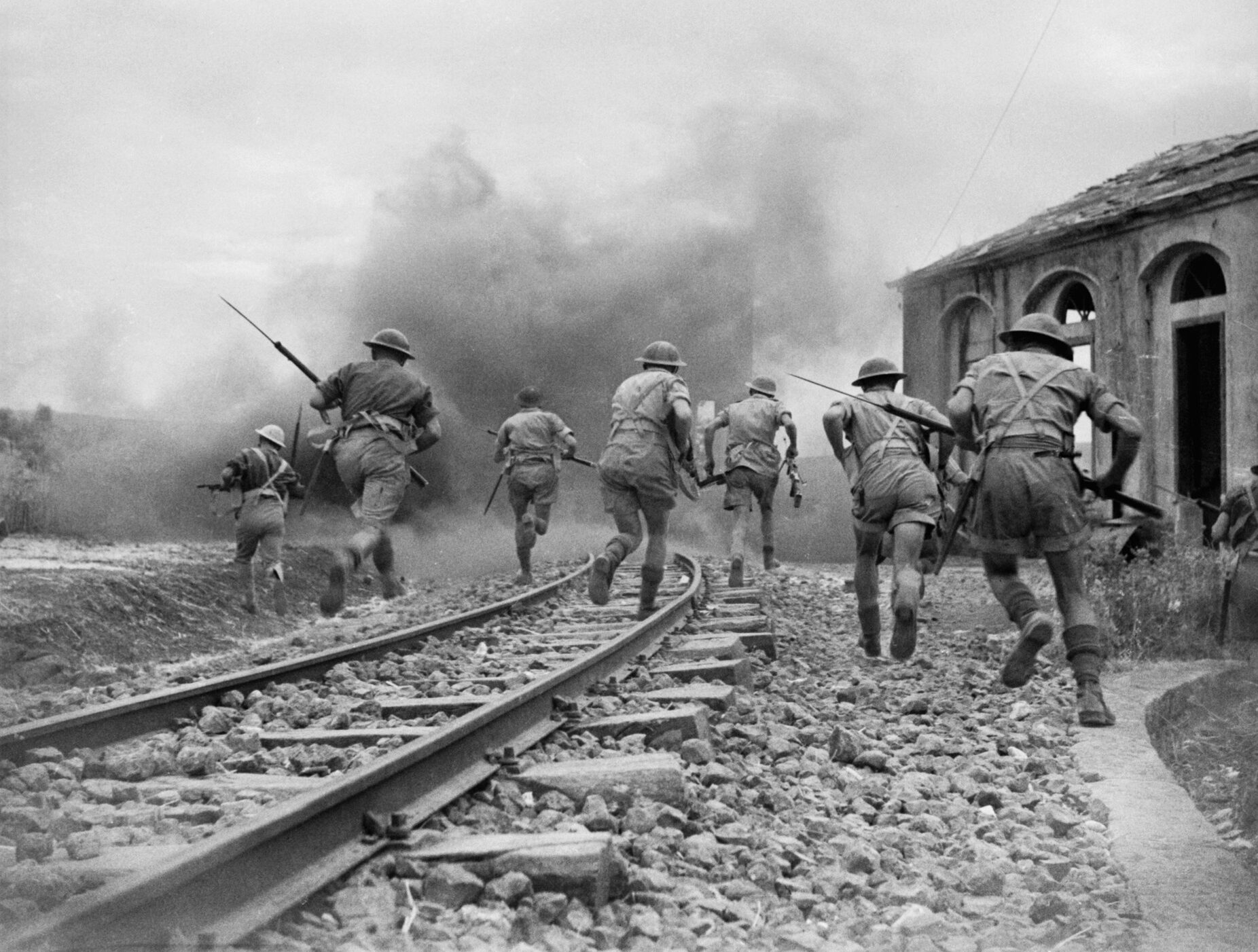
By midday on July 22, Truscott was perched atop a ridgeline overlooking Palermo. Truscott managed to send two battalions into the city to secure the docks, and an impromptu surrender was arranged after 7 pm with the assistance of a bedsheet tied to a fishing pole and waived atop a speeding scout car headed to the Royal Palace. Patton was delighted as he took up residence in the king’s apartment in the palace and dined on captured German champagne and food.
The drive north to Palermo had inflicted 2,300 casualties on the Axis forces with fewer than 300 American casualties. The Americans captured more than 53,000 enemy troops in the process, mostly Italians. Within days Patton would be eyeing ways to get American forces to Messina, 150 miles to the east, before Montgomery.
In the meantime, the Allied high command began considering the best way to wrestle mainland Italy from the Axis. The war had been going badly for the Italians under Mussolini, and on July 25, 1943, Il Duce was summoned by King Victor Emmanuel III to his private hunting lodge north of Rome. Victor Emmanuel, whom Mussolini had privately called “the little sardine” for years, told Il Duce that he must resign. Mussolini was whisked away, and celebrations broke out across Rome when the news became known.
Patton was now on top of the world. He was featured on the covers of both Time and Newsweek. In backslapping correspondence back and forth with the president, Roosevelt said he would work to make Patton the “Marquis of Mt. Etna” after the war. Patton now pushed him men toward Messina via a roadway along the north coast of Italy where they could be supported by the U.S. Navy’s large guns offshore.
Patton’s nerves frayed as he pushed on. At one point he threatened to shoot a gun crew that took cover in a copse of trees. The hot, harsh Sicilian conditions and poor medical facilities continued to take their toll on the advancing Americans. Patton pushed his forces relentlessly. In August, Patton on two separate occasions slapped shell-shocked American soldiers in field hospitals. The fallout from the incidents would have major repercussions for both Patton and the U.S. Army.
The advance seemed to grow ever more difficult for the tired, sun-bleached Americans. The Germans had managed to blow up more than 150 bridges to slow the advance and made prodigious use of deadly mines. Although the Italians seemed to lose heart with Mussolini’s downfall, their German allies only seemed to grow tougher. As they advanced over Sicily’s hardscrabble interior, the Allies became more reliant on mules to transport men and matériel. The mules, for their part, also seemed to resent the Sicilian sun and rough terrain. One soldier assured all listeners that the only way to get a mule to behave “was to bite him on the ears.”
At this point, the British main force was spidering carefully up against Mt. Etna’s foothills, and its right flank was blocked at Catania. The U.S. Army was working toward Messina along two parallel roads, and the 1st Division managed to take Enna after the Germans pulled out.
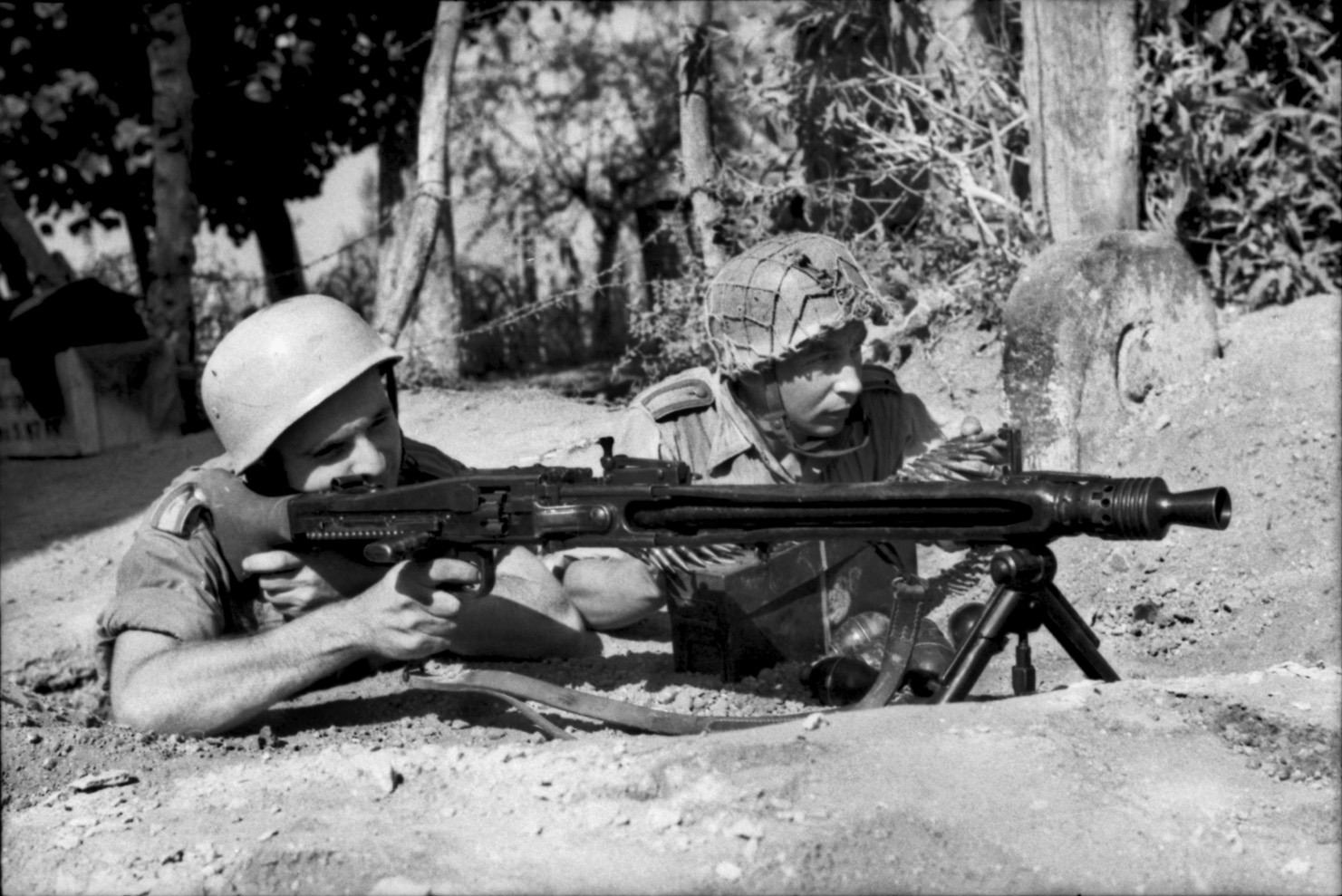
The Allied troops were now butting into the fortified Etna Line that ran from San Fratello along the northern coast through Troina then southeast below Mt. Etna. The Germans chose to reinforce Troina, located on the highest hilltop in Sicily and on the crucial east-west Highway 120. The 15th Panzergrenadier Division withdrew from western Sicily and entrenched at Troina. The Germans placed minefields and strongpoints north and south of the city and positioned four artillery batteries to the east. Attackers from the west would be channeled by the terrain into an open and potentially deadly three-mile run of Highway 120. The presence of panzers only added to Allied anxiety.
The American move toward Troina and nearby Cerami began August 1 with the 39th Infantry moving against the entrenched Germans who held the high ground. The enemy firepower, mainly mortars and machine guns, proved withering to the exposed attacking forces. The attrition over the next few days was appalling. By August 5, the 1st Division’s rifle companies had been reduced by two-thirds, and one company in the 26th Infantry had only 17 men fit to tangle with the Germans.
The Americans had had enough at this point, and Allen prepared and laid out a detailed plan to outflank and take Troina. Advancing American patrols found that the Wehrmacht had withdrawn earlier on August 6 and trundled farther eastward on Highway 120. In addition, the Hermann Göring Division had pulled back from Catania on the east coast. Troina was a mess of destroyed houses and buildings with more than 150 dead lying about.
“Troina was the toughest battle since World War I” for Americans, said Maj. Gen. John Lucas. The 1st Division recorded more than 500 casualties with the 39th suffering as well. Off the battlefield the casualties included the relief of Allen, the division’s commanding general, and Roosevelt, the assistant commander. Bradley brought about the changes in command, citing Allen’s supposed poor temperament and related factors. The moves shocked and surprised the soldiers of the division, with Maj. Gen. Clarence R. Huebner taking the helm of the 1st Division.
With the abandonment of Catania by the Germans, Montgomery’s right wing was able to advance after being stalled for two weeks. As the Allies eventually hoofed it forward past Mt. Etna, what had been a 170-mile front narrowed to 45 miles on the Messina Peninsula. As the 100,000 enemy soldiers pulled back, the Allied air forces dropped bombs on the retreating troops and managed to obliterate a good many Sicilian towns in the process.
As usual in the Sicilian campaign, not everything went smoothly. There was an effort to land a battalion 12 miles behind the German lines near Brolo on Sicily’s northern coastal Highway 113. By taking that and nearby Monte Cipolla, the Americans would cut the enemy’s escape route. American landing tanks and equipment got tangled up on the beach. The attack failed.
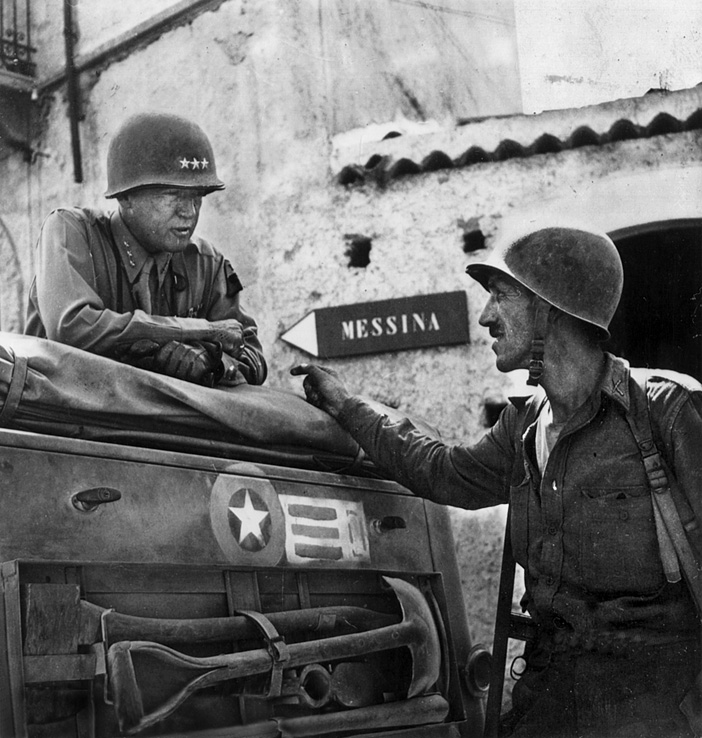
The Germans counterattacked, and Allied airmen contributed to the confusion by errantly bombing a friendly command post and destroying American artillery positions. By August 12 the Germans had again pulled back, destroying a mountainous section of Highway 113 in the process.
Kesselring was no fool. As early as mid-July he had privately acknowledged that his veteran infantry must be saved to fight another day. Kesselring relied on Colonel Ernst-Gunther Baade, who managed to have some 500 guns placed along the shores of Messina Strait. He rustled up 33 barges, 76 motorboats, and a dozen “Siebel ferries” (large rafts propelled by a pair of airplane engines mounted on pontoons). German engineers built a dozen ferry sites designed so motorized vehicles could both drive on and off the ferries, thereby speeding the evacuation of Sicily when the time came. Equipment that could not be taken from the island was destroyed.
Yet again, Allied air attacks failed Operation Husky. Bombers never appeared over the straits at that point to destroy the fleeing concentrations of enemy men and matériel. Most available heavy bombers had been assigned to hit targets on the Italian mainland, and Allied naval commanders were leery of the potential of coordinated German artillery fire. The Allies, in short, had become so focused on the upcoming invasion of the Italian mainland that they neglected to consider the advantages of isolating, cornering, and destroying the enemy on Sicily.
But the Allied ground forces pressed on. By the evening of August 16, American units had slipped into Messina before the British and awaited Patton’s grand entry into the city early the following day. Patton admitted in his diary that he felt let down by victory. But soon his spirits would be brought even lower. Written details on the slapping incidents had reached Eisenhower who, in turn, had a harshly worded letter of censure hand delivered to Patton. He headed to the sidelines for reassignment.
In many ways, what happened to Patton was a metaphor for the Sicilian campaign. Despite substantial trials and tribulations, the Americans had risen to the occasion. Despite poor planning and the absence of consistent tactical air support, they did manage to work fairly closely with their British allies on the ground and even more closely with naval support to win the day.
Barely 50,000 determined Germans, aided by poorly led Italian troops, managed to tie up nearly a half million Allied infantry for five weeks despite superior Allied air and sea power. And all this was at a time when the Soviets were engaged in a life-and-death struggle with some 185 German divisions at Kursk and elsewhere on the Eastern Front.
Operation Husky resulted in 21,600 American and British casualties, including nearly 5,000 dead. Axis dead and wounded were more than a third higher at 29,000, including 4,300 German dead and 4,700 Italians killed in battle. The total number of enemy captured was 140,000, mostly Italian soldiers.
The Western Allies still had much to learn in terms of planning and interservice cooperation. The need for dramatically improved tactical air support would be shown again with the landings on the Italian coast, lessons well learned by D-Day in Normandy. The need to seal off escape routes would be shown yet again at the Falaise Gap a year later in France.
The Sicilian campaign was a turning point; the Americans had proven their mettle. Concerns about the debacle at Kasserine Pass in North Africa were laid aside as American military prowess and matériel strength truly began to make a significant difference in the ground war on the European continent.
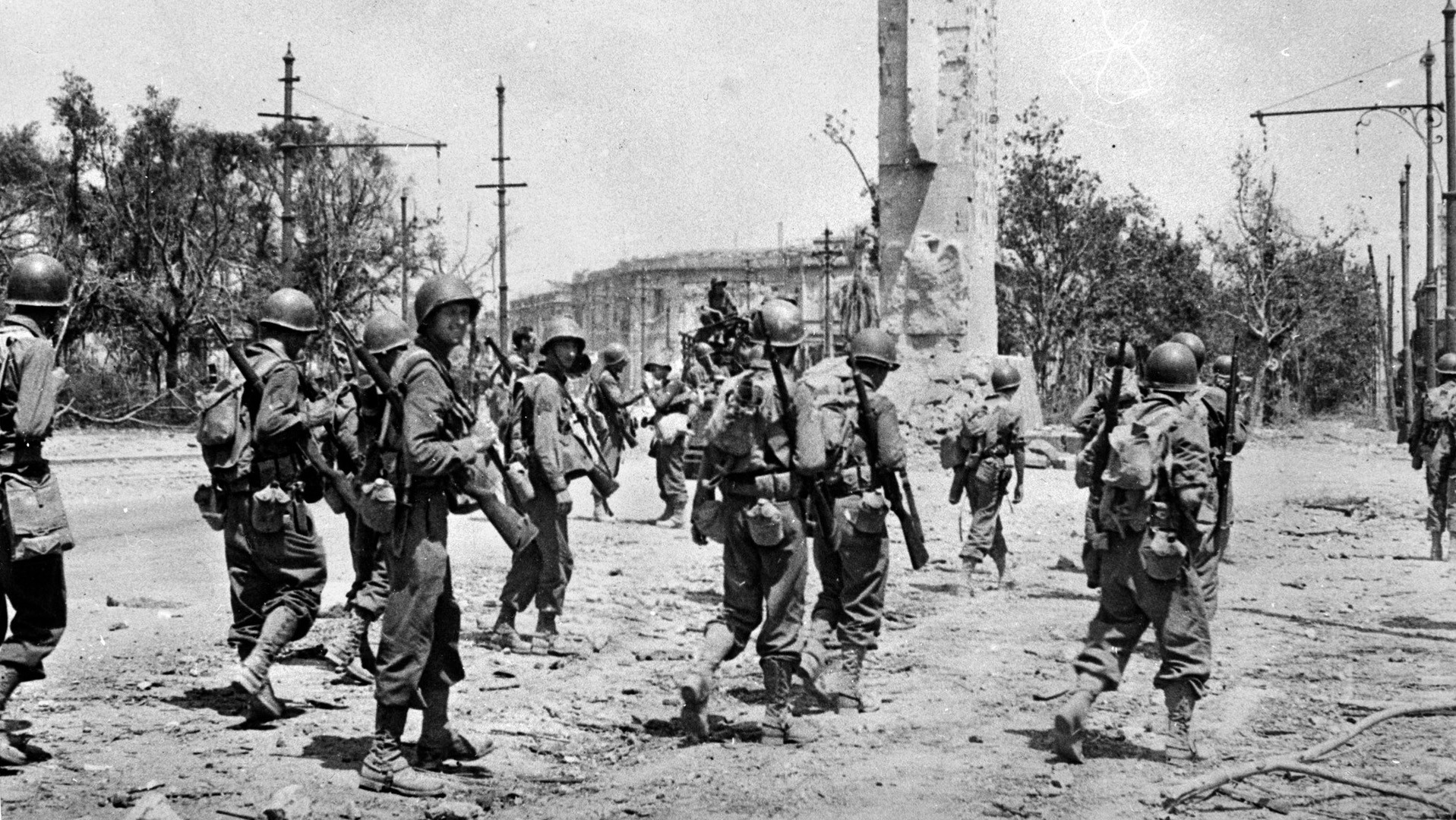
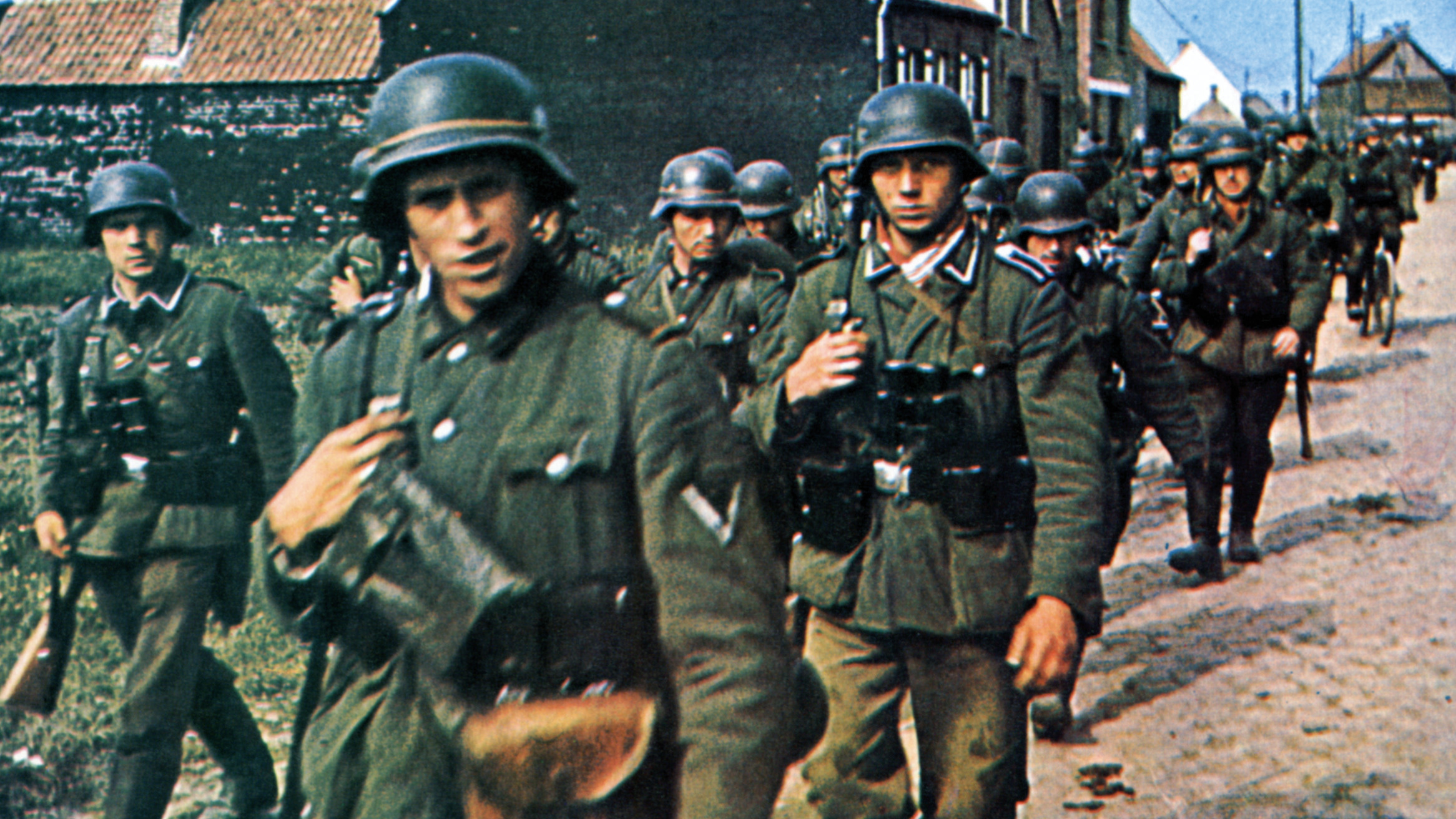
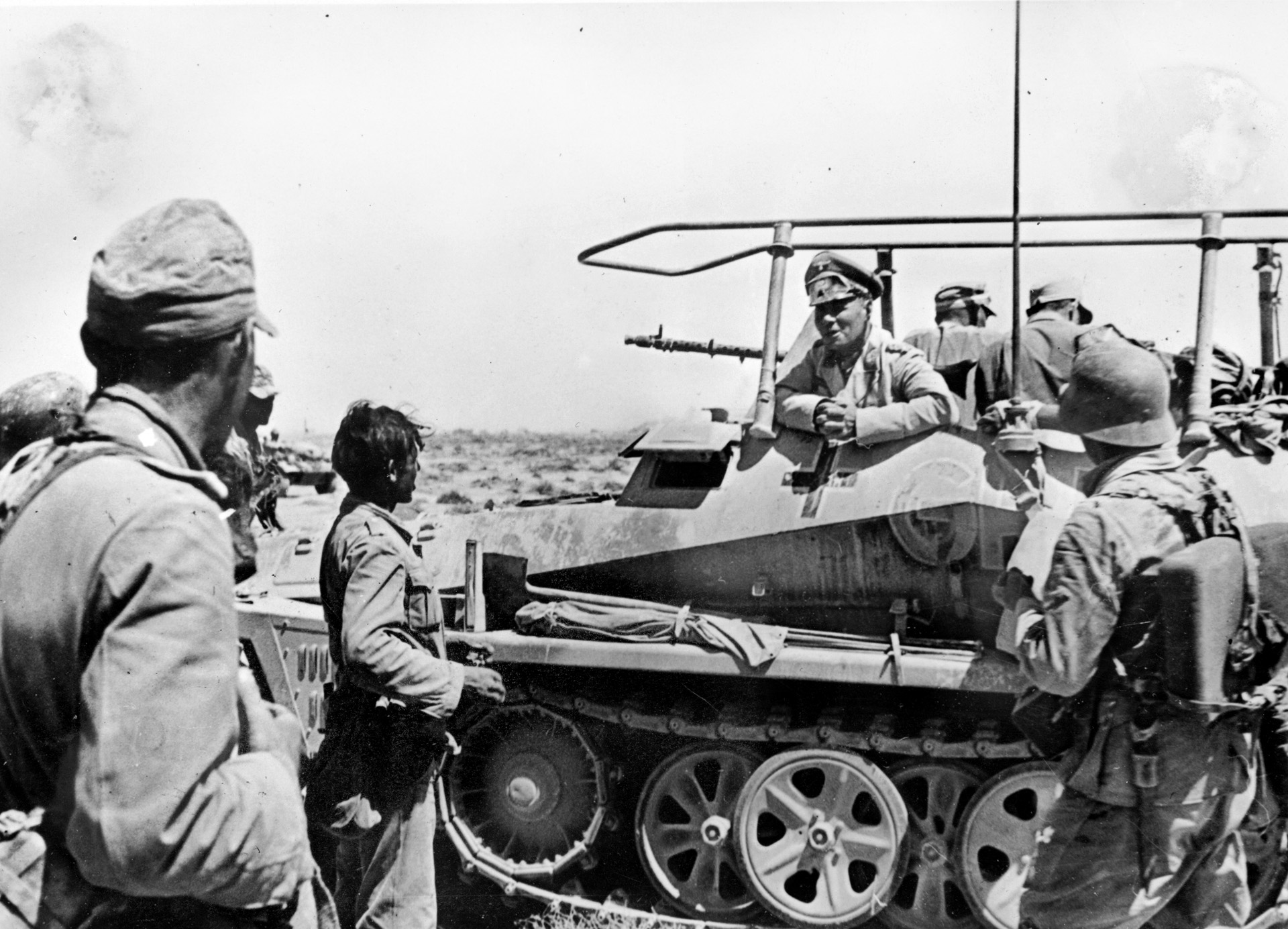
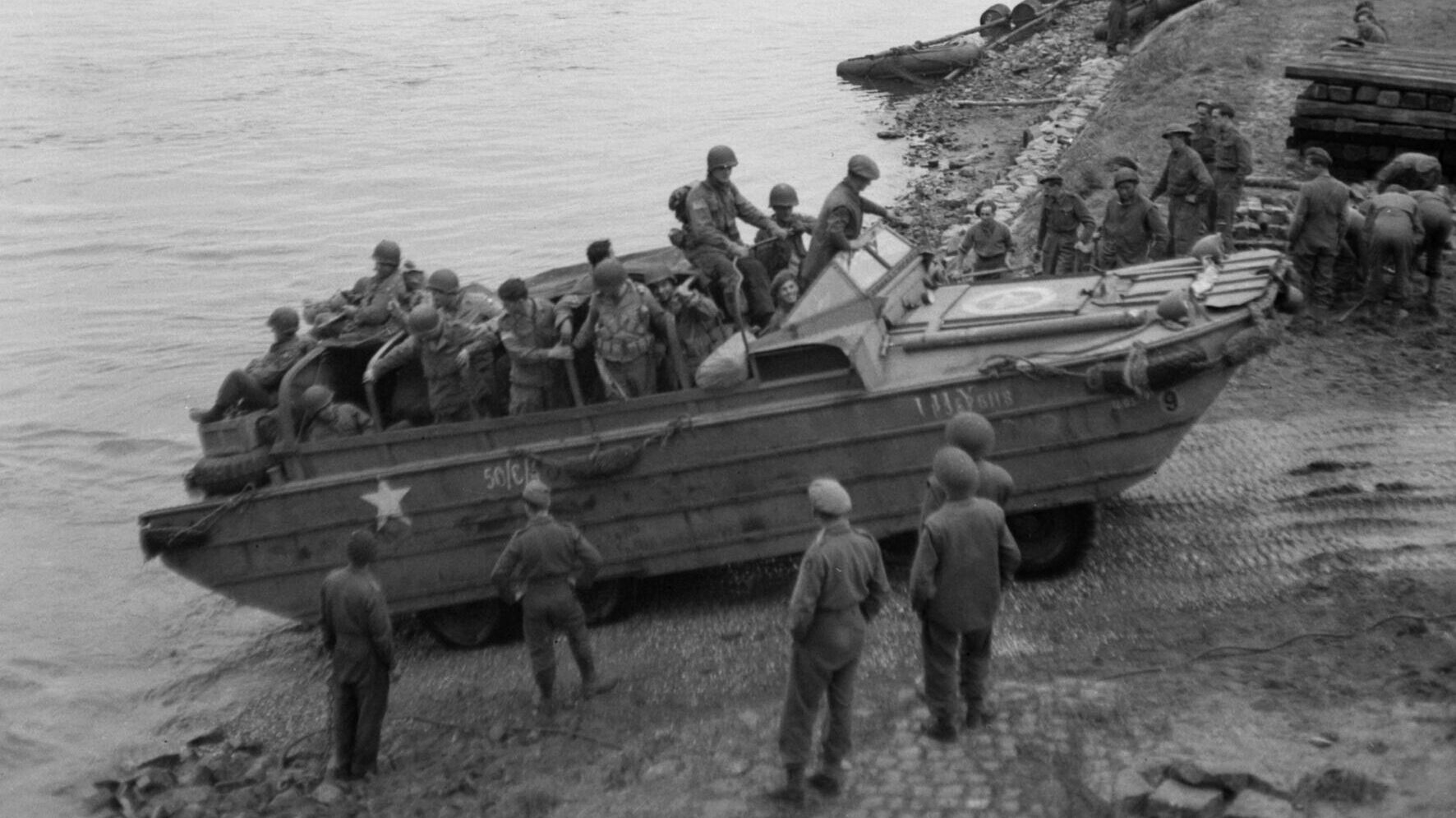
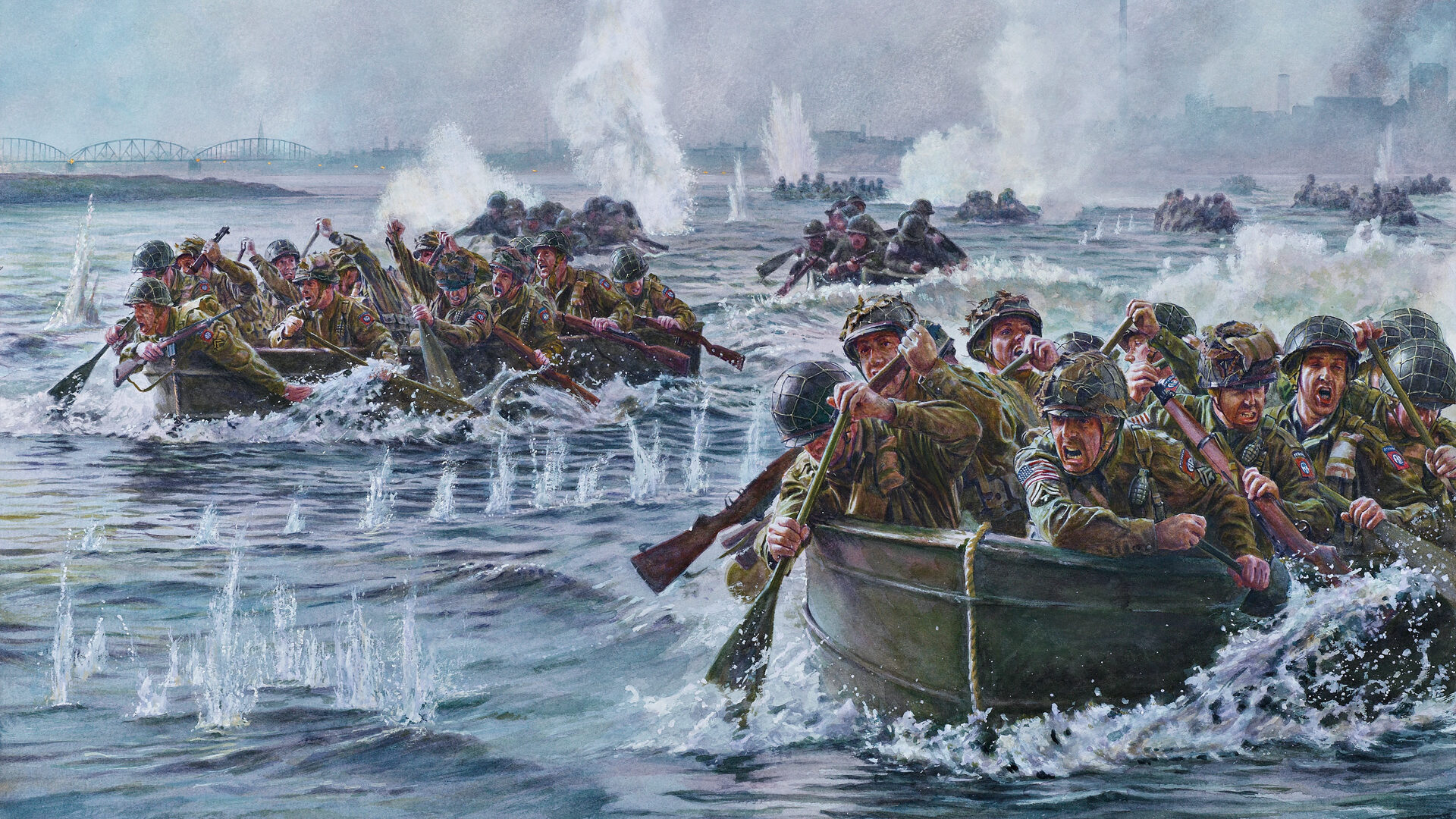
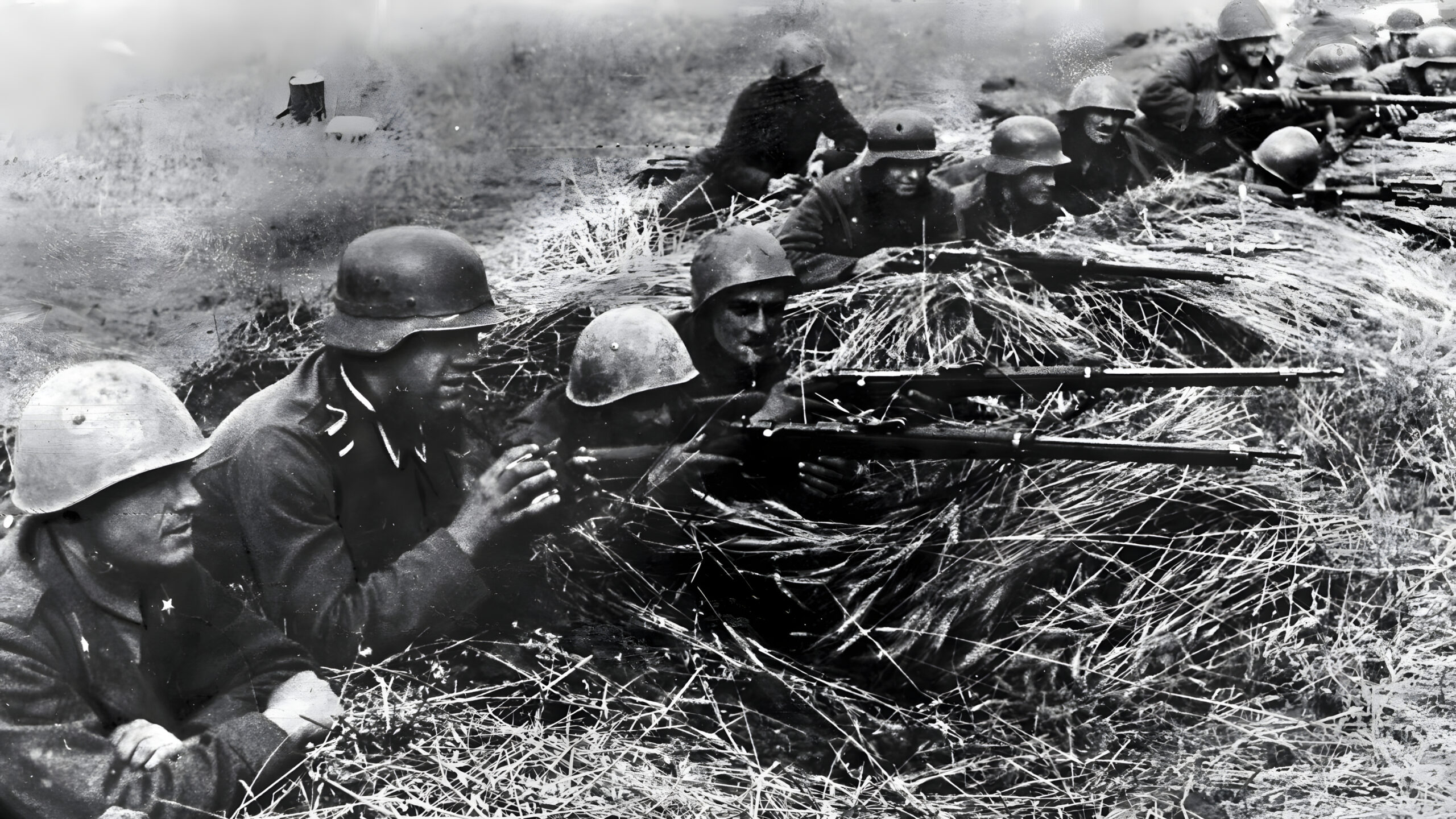
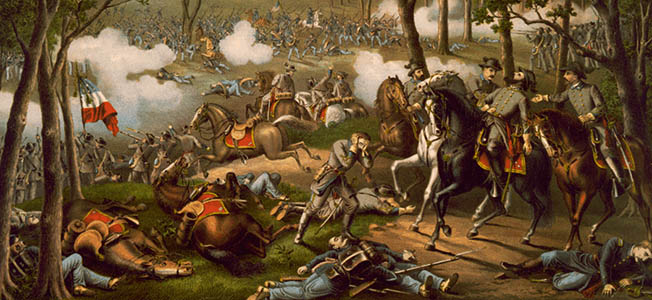
Join The Conversation
Comments
View All Comments